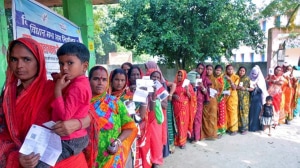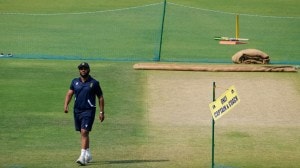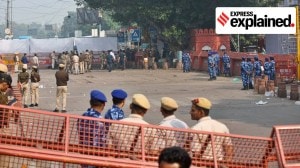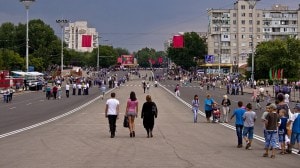Harikishan Sharma, Senior Assistant Editor at The Indian Express' National Bureau, specializes in reporting on governance, policy, and data. He covers the Prime Minister’s Office and pivotal central ministries, such as the Ministry of Agriculture & Farmers’ Welfare, Ministry of Cooperation, Ministry of Consumer Affairs, Food and Public Distribution, Ministry of Rural Development, and Ministry of Jal Shakti. His work primarily revolves around reporting and policy analysis. In addition to this, he authors a weekly column titled "STATE-ISTICALLY SPEAKING," which is prominently featured on The Indian Express website. In this column, he immerses readers in narratives deeply rooted in socio-economic, political, and electoral data, providing insightful perspectives on these critical aspects of governance and society. ... Read More
BJP wins Tripura, but with all-round fall in tally, vote share, average winning margin
TIPRA wins by average highest margins, numbers show Congress clearly gained from Left tie-up; Nagaland saw most seats won by lowest margins.
 Prime Minister Narendra Modi being garlanded by BJP President J P Nadda and Union Minister Amit Shah during celebrations after the party's good performance in Nagaland, Tripura and Meghalaya Assembly polls, at the BJP HQ in New Delhi, March 2, 2023. (PTI)
Prime Minister Narendra Modi being garlanded by BJP President J P Nadda and Union Minister Amit Shah during celebrations after the party's good performance in Nagaland, Tripura and Meghalaya Assembly polls, at the BJP HQ in New Delhi, March 2, 2023. (PTI) An analysis of Thursday’s Assembly results from the three Northeast states that went to polls shows that 10 seats in Tripura, 15 in Meghalaya and 19 in Nagaland were won by a margin of less than 1,000 votes. The average winning margin in the states was 5,009, 3,186, and 2,975, respectively.
All three states have 60 Assembly seats each.
Tripura
The state’s Jubarajnagar Assembly constituency — where the CPI(M)’s Sailendra Chandra Nath defeated the BJP’s Malina Debnath by only 296 votes — recorded the lowest victory margin. The highest winning margin was in Takarjala, where the TIPRA Motha’s Biswajit Kalai defeated the Indigenous People’s Front’s (IPFT) Bidhan Deb Barma by 32,455 votes.
A total of 10 seats were won by a margin below 1,000 votes. Additionally, 13 seats saw a margin between 1,000 and 2,000 votes; eight seats recorded margins between 2,001 and 3,000 votes; two seats between 3,001 and 4,000 votes; eight seats between 4,001 and 5,000 votes; while 19 seats saw a victory margin of over 5,000 votes.
While the BJP returned to power, the party’s seat tally, vote share and average victory margin declined in comparison to the 2018 Assembly election results. In 2018, the BJP had won 36 seats by an average winning margin of 4,606 votes, and secured a vote share of 43.59 per cent. In 2023, while the BJP tally came down to 32, its average victory margin was 3,458 votes and its vote share 38.97 per cent.
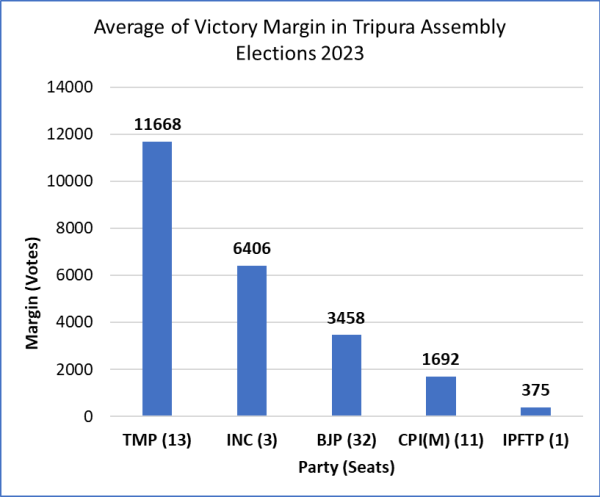
However, the BJP stood second across 21 seats in 2023, as against 16 seats in 2018 — showing the expansion of the party’s base.
The party’s average victory margin (3,458 votes) across its tally, though, was lower than its average trailing margin (3,764 votes) in the 21 seats where it finished runner-up.
Of its 32 seats, the BJP won 18 against the Left Front – 16 against the CPI(M), and 1 each against the All India Forward Bloc (AIFB) and RSP — 7 against the Congress, 6 against the TIPRA Motha, and 1 against an Independent.
In the 2018 assembly elections, of the BJP’s 36 seats, 33 had come against the CPI(M), and 1 each against the AIFB, IPFT and RSP. The BJP had later allied with the IPFT; the tribal party fought with the BJP in a pre-poll coalition this time.
The TIPRA Motha won most of its seats against the BJP. The parties saw a direct contest in 13 seats, of which seven were won by the TIPRA. It won 4 against the CPI(M) and 2 against the IPFT, finishing as the second-largest party with 13 seats.
The TIPRA Motha also recorded the highest average winning margin of all parties in Tripura, at 11,668 votes.
The CPI(M) which won 11 seats, and its partner Congress that got 3, won all their seats against the BJP. However, in seats where there was a direct contest between the CPI(M) and BJP, the latter won more seats – of 27 such seats, the BJP won 16.
The CPI(M) also won by average lower margins, and lost by average bigger margins.
While its average victory margin across its 11 seats was 1,692 votes — down from 3,305 in 2018 – its average trailing margin in the 21 seats it came second was 5,347 votes. Its average trailing margin hence rose from 2018’s 4,638 votes.
The Congress clearly benefited from the “understanding” with the CPI(M) – the parties insisted it was not an alliance. The Congress won 3 seats, against 0 in 2018, and its vote share increased from 1.86 per cent to 8.56 per cent. Its average winning margin was 6,406 votes, almost double the BJP’s.
Nagaland
The lowest victory margin here was in Western Angami constituency, where the candidate of the Nationalist Democratic Progressive Party (NDPP), Salhoutuonuo Kruse, defeated Independent nominee Keneizhakho Nakhro by just 7 votes.
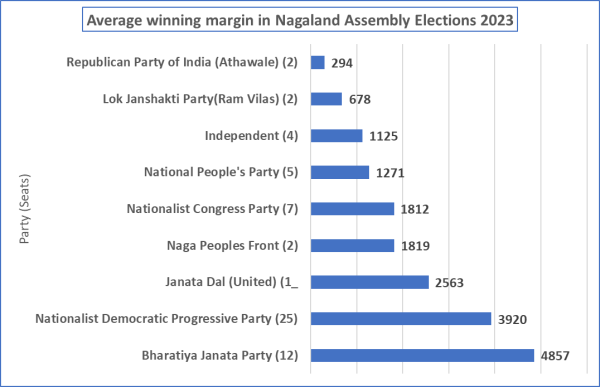
Kruse was one of the two women to win this time in Nagaland, becoming the first women MLAs to ever be elected in the state. The second woman MLA also belongs to the NDPP.
The highest victory margin was recorded in Ghaspani-I constituency, where the BJP’s N Jacob Zhimomi defeated Independent V Phushika Aomi by 20,096 votes.
In Nagaland, 19 seats were decided by a margin of less than 1,000 votes.
Meghalaya
Across the three states, Meghalaya recorded the lowest average winning margin. Here, 15 seats were decided by a margin of less than 1,000 votes. The lowest winning margin in the state was in Rajabala, where Mizanur Rahman Kazi of the Trinamool Congress (TMC) defeated Md Abdus Saleh of the National People’s Party (NPP) by just 10 votes.
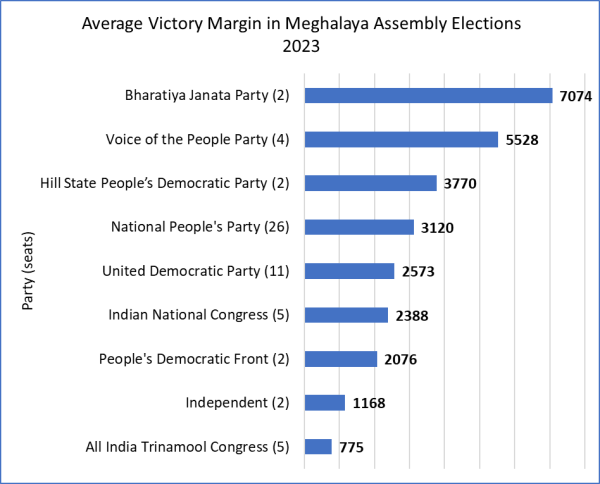
The highest winning margin of 15,648 votes was recorded in Mawlai, with Brightstarwell Marbaniang of the Voice of the People Party defeating Teiborlang Pathaw of the NPP.





- 01
- 02
- 03
- 04
- 05









